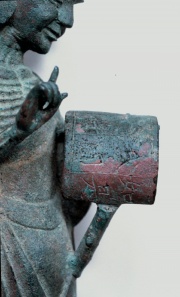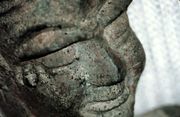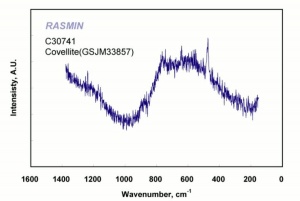Copper sulfide
Jump to navigation
Jump to search
Description
Dark blue hexagonal crystals or black powder. Copper sulfide occurs in nature as the blue mineral Covellite, that turns black in air. It is used in antifouling paints and in textile dying with Aniline black. Copper sulfide was probably used as a black pigment in antiquity (Orna et al 1980). Spots of black copper sulfide can sometimes be seen on corroded bronzes.
Synonyms and Related Terms
covellite (Pigment Blue 34; CI 77450;); cupric sulfide; indigo copper; kopersulfide (Ned.)
Risks
- Irritating to skin and eyes.
- Highly toxic by ingestion.
- Can emit highly toxic hydrogen sulfide gas it exposed to high heat or acid.
Physical and Chemical Properties
Soluble in nitric acid. Insoluble in water, ethanol, dilute acids, alkalis.
| Composition | CuS |
|---|---|
| Mohs Hardness | 1.5 - 2.0 (covellite) |
| Melting Point | 220 C (dec) |
| Density | 3.9-4.6 g/ml |
| Molecular Weight | mol. wt. = 95.61 |
Additional Images
Resources and Citations
- M.V.Orna; M.J.D.Low, N.S.Baer, "Synthetic Blue Pigments: Ninth to Sixteenth Centuries. I. Literature" Studies in Conservation, 25:53-63, 1980.
- Richard S. Lewis, Hawley's Condensed Chemical Dictionary, Van Nostrand Reinhold, New York, 10th ed., 1993
- Henry Hodges, Artifacts: An Introduction to Early Materials and Technology, Ronald P. Frye, Kingston, Canada, 1988
- Monona Rossol, The Artist's Complete Health and Safety Guide, Allworth Press, New York, 1994
- The Merck Index, Martha Windholz (ed.), Merck Research Labs, Rahway NJ, 10th edition, 1983 Comment: entry 2724
- Wikipedia: http://en.wikipedia.org/wiki/Copper_sulfide (Accessed Sept. 7, 2005)



